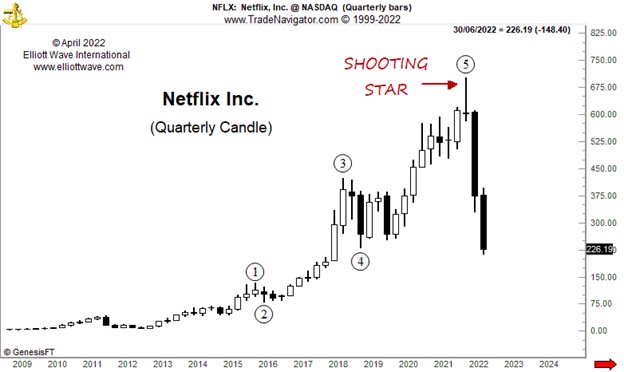Another One Bites the Dust – The Deflation of Netflix
Bubbles are popping, one by one.
The share price of Netflix plummeted last week, coinciding with news that it is losing subscribers, a big change after years of growth. The media and conventional analysts will, of course, link the cause of the share price decline to the news but the chart below disputes that. More on that later. In the meantime, there are two aspects to consider with what is happening here.
Firstly, the deflation of Netflix shares is the latest domino to fall in a chain of popping bubbles since last year. Electric vehicles, SPACS, meme stocks and crypto / NFTs have all seen spectacular crashes in many asset prices. Fueled by a manically positive social mood, assets such as these were pumped up on hot air only to deflate as the consequence of herding behavior took hold. Netflix, the doyen of subscription broadcasters, was not immune and is now reaping the same result. Herding behavior, ironically enough, is in the DNA of broadcast media such as Netflix. When a show such as the Netflix-produced “The Crown” starts to trend on social media, its popularity is driven by quintessential herding behavior. It’s the same dynamic across all popular culture of course.
The second aspect to consider about the Netflix news is that it is a clear signal of demand destruction taking hold in the economy. The best cure of rising prices is rising prices goes the old saw, meaning that as consumer prices rise, demand will fall, and prices will stabilize. With consumer price inflation running rampant, households are examining their budgets and cutting back on what is not necessary. The stagflation that is being talked about now (low economic growth with high consumer price inflation) is a precursor to outright deflation as the low economic growth turns to recession and contraction.
Coming back to the “cause” of the Netflix collapse, the chart below shows that this latest news about losing subscribers has come well after the 2021 peak in the share price. The quarterly Japanese candlestick chart shows that a clear (and appropriate for the entertainment industry) Shooting Star pattern occurred in the final quarter of 2021. This bearish signal also occurred after a five-wave advance since 2009. Thus, coming into 2022, the stage was already set for a decline in the fortunes of Netflix.
As economic and financial conditions continue to tighten, expect many more dominoes to fall.

A “smart” investor knows more than how to pick a stock. Truly smart investors look at stocks…and bonds…and cryptos…and commodities — to understand the BIG picture.
Only then a certain wisdom emerges that helps you make truly informed, truly smart decisions.
Our friends at Elliott Wave International are helping you gain just that, FREE, with a new global market overview video recorded for MoneyShow by their Head of Global Research, Murray Gunn.
U.S., China, Russia, Bitcoin, bonds, commodities… The global economy is changing fast — and Murray’s view from 30,000 feet highlights new risks and opportunities ahead.
And at the end, Murray gives you the 3 big takeaways:
- Are bonds in a bull or bear market?
- Will U.S. stocks outperform or underperform Europe and China?
- What’s next for commodities, short- and long-term?
FREE, watch now: “Around the World’s Risks & Opportunities with Elliott Waves in 28 Minutes” >>